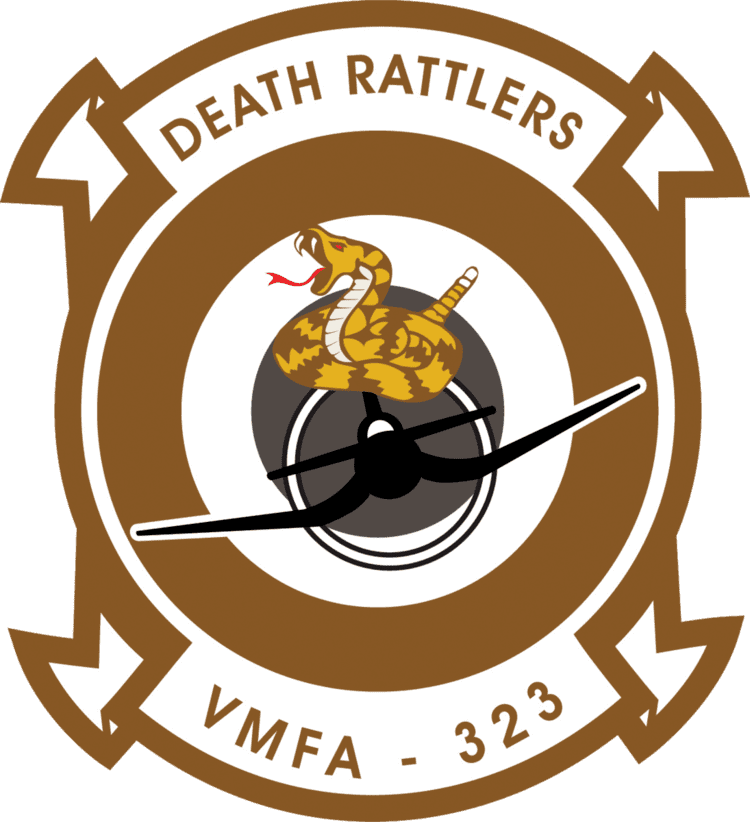Country United States | Branch USMC | |
 | ||
Active August 1, 1943 – present Role Close air supportAir interdictionAerial reconnaissance Part of Marine Aircraft Group 113rd Marine Aircraft Wing | ||
Marine Fighter Attack Squadron 323 (VMFA-323) is a United States Marine Corps F/A-18 Hornet squadron. The squadron is based at Marine Corps Air Station Miramar, California and falls under the command of Marine Aircraft Group 11 (MAG-11) and the 3rd Marine Aircraft Wing (3rd MAW) but deploys with Carrier Air Wing 11.
Contents
World War II
VMF-323 was commissioned August 1, 1943 at Marine Corps Air Station Cherry Point, North Carolina. According to oral history, the squadron got its name from three fighter pilots who killed a 6-foot rattlesnake and hung its skin in the squadron's ready room. VMF-323 began training in F4U Corsairs almost immediately for combat in the Pacific theater of World War II. Much of the new squadron's training was done at Marine Corps Air Station El Centro and Marine Corps Air Station Camp Pendleton, California. In July 1944, the Death Rattlers departed for the Pacific aboard the USS Long Island. For the next nine months, VMF-323 flew training missions from secure island bases in the South Pacific.
On April 9, 1945, the Death Rattlers flew into Kadena airfield in support of Operation Iceberg during the Battle of Okinawa. Combat operations commenced the following day. Between then and the Japanese surrender in August, the Death Rattlers racked up 124 Japanese planes shot down without a single loss. Twelve Death Rattlers became aces.
After the war, the Death Rattlers were based at Marine Corps Air Station El Toro, where they conducted training exercises. It was around this time that the squadron appeared in the 1949 movie Sands of Iwo Jima.
Korean War and post-war
When the Korean War began in 1950, VMF-323 began combat operations from the USS Badoeng Strait as part of Marine Aircraft Group 33 (MAG-33), supporting ground forces in the Battle of Pusan Perimeter, Battle of Inchon, Battle of Chosin Reservoir and almost every other major campaign of the conflict. During action near Kosong, on August 11, 1950, a VMF-323 Corsair pilot, Captain Vivian M. Moses, became the first Marine aviator killed in Korea. The unit also took part in the attack on the Sui-ho Dam in June 1952.
The squadron was re-designated Marine Attack Squadron 323 (VMA-323) in June, 1952. The Death Rattlers left Korea in July 1953. Once back home, the squadron began flying the F9F Panther and then the F9F Cougar, a swept-wing version of the Panther. In 1956 the squadron adopted the FJ-4 Fury, with which it deployed to the western Pacific in 1957. That year, the Death Rattlers flew armed patrols over the Quemoy and Matsu islands to support Chinese nationalist forces.
Returning to MCAS El Toro in 1959, the squadron switched to the F8U Crusader and were assigned to the USS Oriskany.
In 1964 the squadron returned to MCAS Cherry Point, where they received their present designation of Marine Fighter Attack Squadron 323 (VMFA-323). This same year, the Death Rattlers began flying the F-4 Phantom II. During the Dominican Crisis in 1965, the Death Rattlers provided air cover while American citizens were evacuated.
Vietnam War
As the United States grew closer to war in South Vietnam, the Death Rattlers deployed to Da Nang Air Base beginning on October 25, 1965. Combat operations started the day after they arrived. The squadron lost its first aircraft a week after they arrived when the squadron's executive officer was shot down by a Surface-to-air missile over North Vietnam. It was the only Marine F-4 felled by a SAM during the war. 323 remained in Vietnam until 1969, flying combat sorties from Da Nang and Chu Lai.
1980s to 2001
The squadron embarked on its only aircraft carrier cruise in the F-4 Phantom in Nov 1979 aboard the USS Coral Sea, CV-43. After liberty stops in, Korea, Thailand, and Singapore, the Coral Sea arrived in the Arabian Sea in Jan 1980 flying protection caps for the Coral Sea and sister carrier USS Nimitz. On 24 April 1980, VMFA-323 was prepared to fly combat missions into southern Iran in support of US hostages rescue attempt Operation Eagle Claw with the mission to shoot down any Iranian combat aircraft that attempted to take off. When Operation Eagle Claw failed, VMFA-323 F-4's flew missions around the clock until all US support ships had exited the Persian Gulf & Gulf of Oman. The squadron was awarded the Presidential Unit Citation for its service. The squadron arrived back at Subic Bay, RP after 102 straight days at sea. On September 14, 1982, VMFA-323 transitioned to its current aircraft, the F/A-18 Hornet. In October 1985, the squadron deployed again aboard the USS Coral Sea (CV-43), this time to the Mediterranean Sea. In spring of 1986 during Freedom of Navigation exercises held in international waters and airspace off the coast of Libya. Later on April 15, 1986 provided SAM suppression and fighter Combat Air Patrol (CAP) sorties during Operation El Dorado Canyon.
In 1994, 1995, 1997, 1999, and 2001 the Death Rattlers flew missions in support of Operation Southern Watch.
Global War on Terror
On 2 November 2002, VMFA-323 deployed aboard the USS Constellation as part of CVW-2 to conduct Operation Southern Watch. While on this deployment, the Death Rattlers transitioned from Operation Southern Watch to Operation Iraqi Freedom conducting sorties into Baghdad on the first night of the war.
On May 2, 2005, two F/A-18C Hornet fighter jets from VMFA-323, BuNo 164721 and BuNo 164732, collided over south-central Iraq, during a sortie from the USS Carl Vinson, killing the executive officer and a junior officer.
